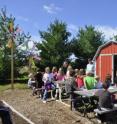Availability of local food key to improving food security
Most strategies to assist the hungry, including food banks and providing food stamps through the Supplemental Nutrition Assistance Program, are short-term, emergency solutions. Those who rely on these programs face daily shortages of fresh and healthy foods, which lead to poor diet choices, nutritional deficiencies and health problems. An expert at the University of Missouri says the production of sustainable, locally grown foods is key to providing long-term food security for communities. "We have to recognize that access to food is a human right," says Michelle Kaiser, researcher in the School of Social Work in the College of Human Environmental Sciences. "People should be able to get healthy food consistently; access to healthy food will benefit the health of the environment and the people consuming it."
Healthy, affordable food availability is an issue in urban areas, as well as rural areas, Kaiser says.
"People don't think of rural areas as places without healthy foods," Kaiser says. "However, many people live miles from the nearest store, and this makes them less likely to buy fresh, perishable foods because they buy groceries less often. In urban areas, many people buy their food from restaurants or convenience stores, where nutritious food is scarce. Even if there is a nearby grocery store, many people don't have access to reliable transportation to those stores."
Local food production reduces the economic and environmental impact of transporting food. Increasing the availability of whole foods, such as fruits and vegetables, enables people to avoid processed, unhealthy foods. Kaiser describes a few strategies that policy makers and individuals can use to improve access to local, healthy food:
- Farmers that sponsor community supported agriculture (CSA) programs ask consumers to purchase shares of their harvests prior to the growing season. Each week, consumers receive portions of seasonal fruits, vegetables, meat and eggs. A challenge to CSAs is that governmental assistance is not available; consumers directly purchase shares of the harvest rather than food.
- Farmers' markets have been a staple of the American food system since the 1970s. The markets bring locally grown crops to people that might otherwise have difficulty finding fresh, healthy food. Many farmers' markets accept food stamps as payments.
- Community and personal gardens can be planted anywhere from rooftops to apartment complexes. Kaiser says gardens bring people closer to their food and their neighbors. Gardens are increasingly being used by schools as educational tools. To increase the number of community gardens, policy makers should incentivize businesses to convert empty lots into gardens.
- Community food assessments (CFA) are tools to define food-related issues including availability of fresh food, prices of foods, transportation to stores and more. Policy makers and local coalitions can use CFAs to better understand how to improve their community's food situation.
Source: University of Missouri-Columbia
Other sources
- Availability of local food key to improving food securityfrom Science DailyTue, 10 May 2011, 14:30:28 UTC
- Availability of local food key to improving food securityfrom Science BlogMon, 9 May 2011, 18:31:17 UTC
- Availability of local food key to improving food securityfrom PhysorgMon, 9 May 2011, 17:00:35 UTC


